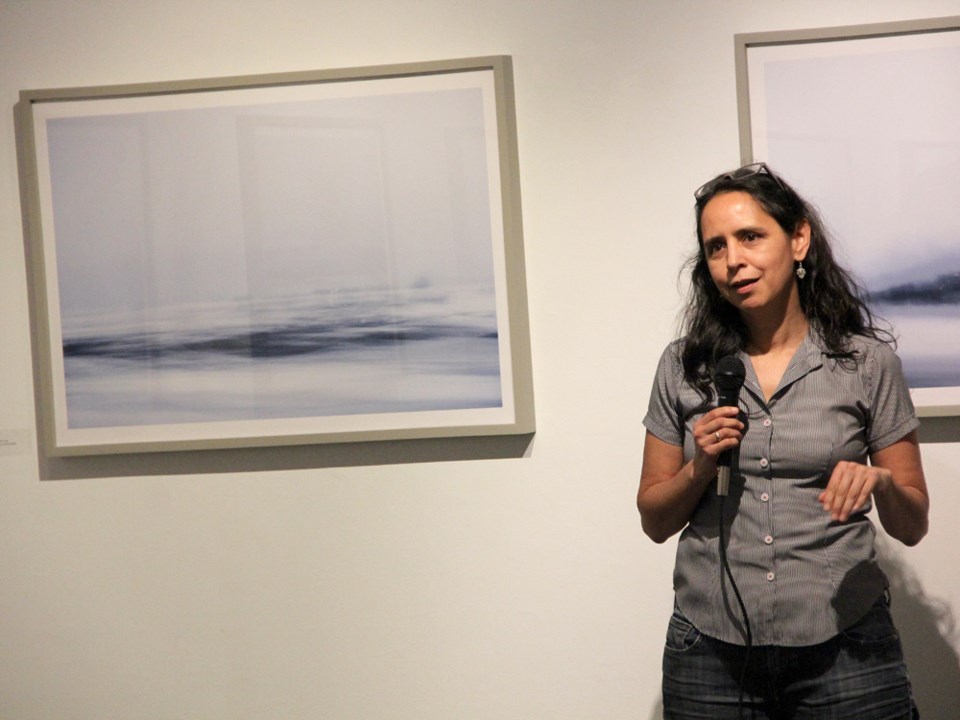Gabriela Garcia-Luna’s White Scapes provide the viewer with an almost blank canvass.
As she said during her talk at the Estevan Art Gallery and Museum’s artist reception for the opening of the exhibit on March 19, however, white is a combination of all light and all colours. When looking closer at these abstract pieces, shapes and motion begin to appear.
Garcia-Luna uses flat and barren, snow-swept prairie landscapes as an exploration of the role space and environments play on our cultures and our individual identities. A native of Mexico City, she moved to Saskatchewan after working in Canada on a pair of grants. Since 2009, she has been living in Moose Jaw.
The change from Mexico City, which isn’t just dense with people but dense with history and geography, to the prairies of Moose Jaw, a city barely more than 100 years old, has had a profound impact on her work. That’s what she explores with the selection of wintry images on display at the art gallery until April 24, how have the prairies changed her and what has remained.
“We are shaped a lot according to the environment. I am coming from a very different environment,” said Garcia-Luna.
She said where she is from in Mexico is spacious, but instead of clouds when looking to the horizon, one sees mountains and volcanoes. The age of the culture, she said also affects not just what one sees but how they feel.
“In contrast, coming and living in Moose Jaw and enjoying the prairies gives you a totally different sense of who you are and how relate to a place. Part of this me is changing, but part of me is always the same, in a way,” she said.
All of her work is photography-based, where it was originally a photograph or was conceptually based on photography. Rather than capturing the world as it is, her photos are much more abstract, with blurred lines evoking motion or chaos.
“In my work, each project responds to a specific moment or emotion,” she said. Sometimes that means photographing landscapes, like the work on display, and other times that involves people or even wallpaper.
“These photographs are about journeying and journeying the land, which is a metaphor for journeying in life. I’m affected by what happens outside, but it’s about what is my inside at this point.”
She uses long exposure techniques and moves the camera throughout the exposure to create a blurred sense of motion.
“It’s not my interest to represent things the way I see them, but it’s more about a way to perceive them and to perceive myself. It’s a more subjective way of thinking than an objective way of thinking.”
In that vein, she said her works don’t always look like photographs, but sometimes appear more akin to sketches or watercolours.
“It’s this ambiguity of the way we see where I find there’s something that we can question, by not having a fixed idea, that this is what I’m seeing and the way I’m seeing it, or this is the message and the only way to interpret it.”
When taking a long-exposure and moving the camera, a photographer doesn’t quite know what the image will look like, unlike a sharp quick exposure that is intended to capture a moment the way it was seen by the human eye.
“Because we are able to capture the images with amazing sharpness in terms of light and exposure, I’m interested in using photography in a different way that gives me other possibilities to read an image. When a camera is used to make still, sharp images, I like moving with the camera and make things that surprise me when they come up,” Garcia-Luna said.
“It serves the purpose of exploring, wondering and finding surprising results,” she added about her long exposures.
“It’s not a portrait. It’s more a metaphor for me,” she said, noting she enjoys hearing people verbally process what they see when they’re viewing her work. “I enjoy listening to that, because it’s so rich. At the same time it’s recognizable, which is the vast space of prairie covered by snow that we know, those who have been here. We know it, right? So there’s a connection with a state that we know and with the way we feel in that space.”




